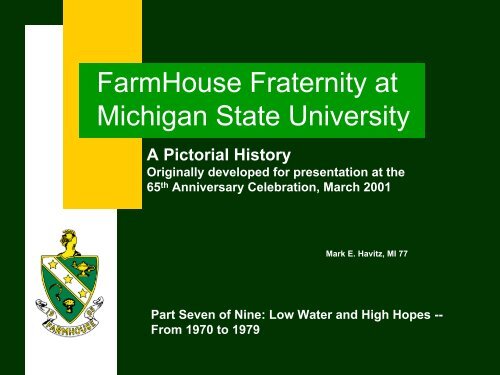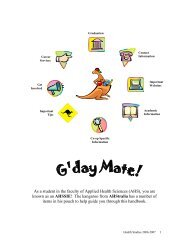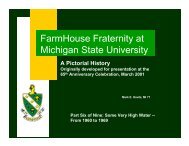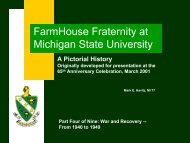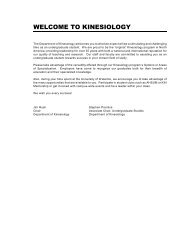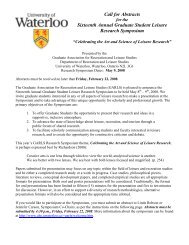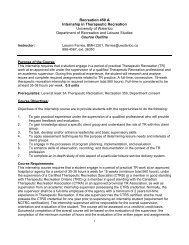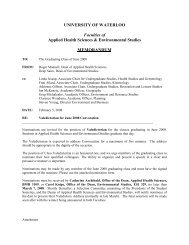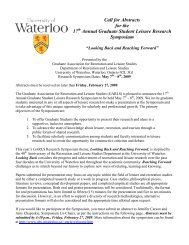FarmHouse Fraternity at Michigan State University
FarmHouse Fraternity at Michigan State University
FarmHouse Fraternity at Michigan State University
You also want an ePaper? Increase the reach of your titles
YUMPU automatically turns print PDFs into web optimized ePapers that Google loves.
<strong>FarmHouse</strong> <strong>Fr<strong>at</strong>ernity</strong> <strong>at</strong><br />
<strong>Michigan</strong> St<strong>at</strong>e <strong>University</strong><br />
A Pictorial History<br />
Originally developed for present<strong>at</strong>ion <strong>at</strong> the<br />
65 th Anniversary Celebr<strong>at</strong>ion, March 2001<br />
Mark E. Havitz, MI 77<br />
Part Seven of Nine: Low W<strong>at</strong>er and High Hopes --<br />
From 1970 to 1979
As the 70s dawned things were, <strong>at</strong> times, chaotic<br />
<strong>at</strong> the now 45,000 student university. A few years<br />
l<strong>at</strong>er, enrolment topped out <strong>at</strong> just over 48,000.<br />
Farm Lane bridge repairs, such as those <strong>at</strong> left,<br />
th<strong>at</strong> would have been hardly noticed but by c<strong>at</strong>tle,<br />
sheep and their herdsmen a few decades back,<br />
literally brought the campus to a standstill.<br />
[Source: 1978 Red Cedar Log]<br />
Bicycles were everywhere, nothing new for MSU<br />
campus, there were just more of them! The fact<br />
th<strong>at</strong> wide-bottom bells were in style didn’t make<br />
m<strong>at</strong>ters any easier for cyclists. [Source: 1976 Red<br />
Cedar Log]<br />
Sometimes <strong>at</strong> night<br />
I see their faces<br />
I feel the traces<br />
they’ve left on my soul.<br />
Bob Seger<br />
Travlin’ Man (live)<br />
Live Bullet (1976)
In comparison with the past several decades, hairstyles were longer and ties wider as the 1970s dawned. The<br />
Be<strong>at</strong>les shocked the world by breaking up and, much to many people’s surprise, the Rolling Stones did not. The<br />
war in Vietnam raged, the civil rights movement remained high in profile, and women’s liber<strong>at</strong>ion emerged as a<br />
new theme. Infl<strong>at</strong>ion was problem<strong>at</strong>ic for much of the decade and many traditional industries began downsizing<br />
after several solid decades of growth. Politically, socially, and academically, it was a vol<strong>at</strong>ile environment. Here<br />
are brief profiles of a few of the early 1970s men who lived those times.<br />
Denny Arkens ‘70 (left) held several offices including th<strong>at</strong> of President in<br />
1972. After gradu<strong>at</strong>ion he served in sales and management capacities<br />
with Cheesbrough Ponds, Inc. Denny passed away, of cancer, much too<br />
young in 1991. Karl Kincade ‘73 (right) was Arkens’ eventual brother-inlaw,<br />
marrying Denny’s sister Linda after gradu<strong>at</strong>ion. Karl has made his<br />
career in agricultural finance with PCA and Farm Credit Services in<br />
southwestern <strong>Michigan</strong>. [Source: 1972 and 1973 <strong>FarmHouse</strong> Composites]<br />
Brothers Dave ‘72 (left) and Phil Bowen ‘74 (right) arrived from the Thumb<br />
and were also prominent in <strong>FarmHouse</strong> activities, holding offices as<br />
diverse as Secretary and Vice President. A network software analyst in<br />
places as diverse as Texas and Minnesota since gradu<strong>at</strong>ion, Dave also<br />
enjoys barber shop singing. Phil has served the Harbor Beach school<br />
system for over two decades in the capacity as both teacher and coach.<br />
Joe Panci ‘73 (left), a forestry major, was President in 1975. He has spent<br />
most of his career in the Eagle River area of northern Wisconsin, working<br />
for Trees for Tomorrow N<strong>at</strong>ural Resources Educ<strong>at</strong>ion Center. Jim Monroe<br />
‘67 (right) enjoyed a long <strong>FarmHouse</strong> career spanning through 1972. Post<br />
-gradu<strong>at</strong>ion he has worked as an agricultural management specialist with<br />
the Farmers’ Home Administr<strong>at</strong>ion and in Rural Economic and Community<br />
Development in the Traverse City area. An appropri<strong>at</strong>e activity for their<br />
respective homes, both Joe and Jim enjoy cross country skiing.
Although the MSU student body was much larger than in the past, the Vietnam War and associ<strong>at</strong>ed social<br />
changes of the l<strong>at</strong>e 60s and early 70s were hard on a lot of fr<strong>at</strong>ernities. <strong>Fr<strong>at</strong>ernity</strong> membership lost much of<br />
its social necessity. A good number of houses closed during this time. Others struggled mightily. MSU<br />
<strong>FarmHouse</strong> fell into the l<strong>at</strong>ter c<strong>at</strong>egory. Our numbers dropped steadily, if not precipitously in the first half of<br />
the decade as illustr<strong>at</strong>ed by the 1976/1977 composite. Compounding th<strong>at</strong> crisis, nearly half of the guys in<br />
this composite gradu<strong>at</strong>ed in the spring. Pledges were few and far between. Thus, our low mark occurred in<br />
the fall of 1977 when only a dozen active members returned to campus.
<strong>FarmHouse</strong> as a whole and <strong>at</strong> MSU also struggled with the role of women. As you can see from the previous<br />
photo, the “Little Sisters of the Pearl” (LSP) organiz<strong>at</strong>ion, begun n<strong>at</strong>ionally in the 1960s, was seemingly gaining<br />
strength and influence. Though the LSP organiz<strong>at</strong>ion pre-d<strong>at</strong>ed such formal document<strong>at</strong>ion, LSPs first appeared<br />
on MSU <strong>FarmHouse</strong> composites in 1972. A major problem, however, was th<strong>at</strong> it was an auxiliary organiz<strong>at</strong>ion.<br />
Little brothers could soon become big brothers, but not so with little sisters. LSPs like Marcia Foss who joined in<br />
1977 (posing below with the FH rug made by LSPs) gave their hearts and souls to the chapter, but never gained<br />
full membership. This was, after all, a fr<strong>at</strong>ernity. [Source: Mark Havitz, personal photo collection]<br />
LSP presidents from 1972 to 1977 included (from left) Linda Bristol, Elisabeth Buchheister, Colleen Pamp, Linda<br />
Arkens, K<strong>at</strong>hy Kacynski, and Melody Postochow. These were the years during which LSPs were included in<br />
<strong>FarmHouse</strong> composites [Source 1972 - 1977 composites]
The actives and the board struggled with solutions to the chapter’s membership problems. It was tempting to<br />
blame each other. Some did, but most didn’t. Nevertheless, it soon became clear th<strong>at</strong> <strong>FarmHouse</strong> was no longer<br />
financially viable <strong>at</strong> 151 Bogue Street. Much as we loved the house and the loc<strong>at</strong>ion, we were just too small to<br />
support the large facility and were barely viable as an organiz<strong>at</strong>ion. The Associ<strong>at</strong>ion Board made the tough<br />
decision to move the Chapter during the spring of 1977. We moved out th<strong>at</strong> summer and in August the<br />
<strong>FarmHouse</strong> letters were removed from 151 Bogue with a hacksaw, the symbolism mirroring our collective pain.<br />
<strong>FarmHouse</strong> took up residence in three basement units of the Beechwood Apartments, 1130 Beech Street for the<br />
1977-1978 school year. 151 Bogue St. was rented to recently re-colonized Alpha Tau Omega. It hurt seeing the<br />
!IS men (below) in our living room in the MSU yearbook photos. [Photo source: 1978 Red Cedar Log]
We struggled mightily with <strong>at</strong>trition<br />
throughout the decade. The fall 1977<br />
pledge class (right) was typical. From<br />
the seven pledges pictured here in our<br />
Beechwood Apartment chapter room,<br />
only four “went active.”<br />
Many students of th<strong>at</strong> time questioned<br />
the relevancy of fr<strong>at</strong>ernities and their<br />
programs. Individualism was in. “Do<br />
your own thing, only sheep follow<br />
organiz<strong>at</strong>ional rules” was a common<br />
refrain. Hazing was out. Unfortun<strong>at</strong>ely,<br />
we didn’t have enough positive ideas to<br />
replace the neg<strong>at</strong>ive ones th<strong>at</strong> had been<br />
discarded. We changed “pledges” to<br />
“affili<strong>at</strong>e members” and re-vamped our<br />
programs in an <strong>at</strong>tempt to ride out the<br />
storm.<br />
Fortun<strong>at</strong>ely, the guys who stayed were<br />
good ones, including Steve Skrobak<br />
(top row, second from right) and the<br />
three men kneeling in front (Joe Hickey,<br />
Al Bakker, and Roy Messing). [Source:<br />
Mark Havitz, personal photo collection]
We also chose our leaders wisely. The collective will of the few active men and courageous leadership from a<br />
string of strong presidents helped us through. Here are five of them from the crisis years of the mid-1970s: Rusty<br />
Plummer ‘74 of Owosso; Ed Messing ‘74 from Harbor Beach; Steve Anderson ‘76 from Maumee, Ohio; Bryce<br />
Bollwahn ‘75 of Lansing; and Steve Dragt ‘77 from Byron Center [Source: 1976, 1977 and 1978 MSU <strong>FarmHouse</strong><br />
composites].<br />
Plummer Messing Anderson Bollwahn Dragt<br />
Rusty Plummer’s diverse contributions to the <strong>Fr<strong>at</strong>ernity</strong> and <strong>University</strong> also included membership on the MSU<br />
Livestock and Horse Judging teams, the 1977 MSU Homecoming Court, and service on the Associ<strong>at</strong>ion Board.<br />
After gradu<strong>at</strong>ion, Ed Messing earned a law degree <strong>at</strong> Cooley Law School and currently serves as Friend of the<br />
Court for Sanilac County, MI.<br />
After a short stint as President, Ohio n<strong>at</strong>ive Steve Anderson transferred to Ohio St<strong>at</strong>e. He l<strong>at</strong>er earned his Ph.D.<br />
from Ohio St<strong>at</strong>e and now practices as a psychologist in Ohio.<br />
Bryce Bollwahn deserves special note for taking over the presidency <strong>at</strong> perhaps our darkest hour in July of 1977.<br />
Bryce served for two years and guided us through two moves. He even postponed his gradu<strong>at</strong>ion and wedding in<br />
order to complete his second term. Bryce’s f<strong>at</strong>her Lester ‘50 and older brother Keith ‘74 preceded him in<br />
<strong>FarmHouse</strong> and we benefited gre<strong>at</strong>ly from his family’s grounding in our organiz<strong>at</strong>ion. Bryce is an engineer.<br />
Besides being a strong leader Steve Dragt also, until very recently and the 2001 initi<strong>at</strong>ion of Davis Vader (though<br />
John Daly ‘92 may also have a case), held the distinction of “longest hair in a composite” of any MSU FH man! I<br />
guess Steve will have to settle for “longest hair of any 20th Century initi<strong>at</strong>e!” More on Dragt l<strong>at</strong>er.
Intern<strong>at</strong>ional Executive Director<br />
Bob Off CO, ‘64, pictured <strong>at</strong> top<br />
left with his wife Linda, was<br />
concerned and lent a<br />
symp<strong>at</strong>hetic ear. Like D. Howard<br />
Doane had done with the MSC<br />
<strong>FarmHouse</strong> club back in the<br />
1930s, however, he promised no<br />
easy solutions. [Photo source:<br />
Pearls & Rubies]<br />
But in addition to his own<br />
consult<strong>at</strong>ion visits, Off sent some<br />
of the best <strong>FarmHouse</strong> staff to<br />
East Lansing. Visits from C. J.<br />
Gauger IA ‘37, (below right), and<br />
Dave Morford IA ‘73 (not<br />
pictured) helped us through th<strong>at</strong><br />
first critical term outside the<br />
house.<br />
Another renowned <strong>FarmHouse</strong><br />
stalwart, Dr. Hilton Briggs IA ‘33,<br />
(below left) also provided support<br />
and counsel during the l<strong>at</strong>e<br />
1970s as did Assistant Executive<br />
Director Mike Goolsby OK ‘73<br />
(below center). [Source: Pearls &<br />
Rubies, Mark Havitz personal<br />
collection]
Life in Beechwood Apartments seemed odd to those who<br />
had lived in 151 Bogue, but perhaps less so to the half of<br />
our membership th<strong>at</strong> pledged in Winter and Spring terms<br />
of 1977 because we had never actually lived in our large<br />
House. For the l<strong>at</strong>ter group, the Apartments were all we<br />
had ever known of fr<strong>at</strong>ernity life!<br />
Too small for cooper<strong>at</strong>ive purchase, our grocery bill was<br />
nevertheless, fairly lengthy. Here are Dick Waligore ‘77,<br />
Mark Havitz ‘77 and Ken Gross ‘77 showing off our haul<br />
after a bi-weekly trip to Meijers. One interesting incident<br />
occurred early th<strong>at</strong> fall when Treasurer Gross and<br />
Assistant Business Manager Havitz, city boys both, bought<br />
some soy “milk” because it was on sale. Roundly<br />
chastised for the next few days by outraged brothers,<br />
especially the dairy farmers, th<strong>at</strong> was a mistake th<strong>at</strong> was<br />
not repe<strong>at</strong>ed! [Source: Mark Havitz personal collection]<br />
The apartments provided a challenge with respect to fr<strong>at</strong>ernity living. We rented three units. After some<br />
discussion, we alloc<strong>at</strong>ed one of the three apartments for the Chapter. The living room served as our dining and<br />
Chapter room and its two bedrooms served as our office space and study area. In the fall, we put six guys each<br />
into the other two apartments; two in each bedroom and two others in each living room. Unhappy with th<strong>at</strong><br />
arrangement, we opted during Winter and Spring terms to move all 12 beds into a single living room in order to<br />
cre<strong>at</strong>e a dormer sleeping arrangement. Men’s personal effects remained in the various bedrooms. Regardless of<br />
our sleeping arrangements, it always seemed crowded and cluttered. The pressure of adapting to the new<br />
environment, recruiting and maintaining the general functions of a fr<strong>at</strong>ernity were challenging to say the least.<br />
Luckily, we were young. Two last-term seniors, Larry Goostrey ‘76 and Rusty Plummer ‘74 provided stability in the<br />
fall of 1977, but the rest of us had <strong>at</strong> least two undergradu<strong>at</strong>e years remaining. The Beechwood year, or Bumwood<br />
as we called it, was tough; arguably the low point of our <strong>Fr<strong>at</strong>ernity</strong>'s 60-year history. In fact, so deep are the<br />
memories th<strong>at</strong> many of my contemporaries gave me grief 20 years l<strong>at</strong>er for moving to Beechwood Street in<br />
W<strong>at</strong>erloo, Ontario, even though th<strong>at</strong> address was 250 miles from the Beechwood Apartments in East Lansing!
By the spring of 1978 things had improved a bit, but<br />
most members felt th<strong>at</strong> the apartments were stifling<br />
our personal and organiz<strong>at</strong>ional growth. The Chapter<br />
voted to move on and rent a small house <strong>at</strong> 435<br />
M.A.C. Avenue (1978-1979). The house <strong>at</strong> 151<br />
Bogue St. was still rented to Alpha Tau Omega. A<br />
couple more good pledge classes joined, and things<br />
were finally looking up for <strong>FarmHouse</strong>. The MAC<br />
quarters were small and d<strong>at</strong>ed, but the obvious<br />
aesthetic benefits of being on MAC Avenue helped<br />
raise our morale! [Sources: Personal collection of<br />
Dave Ballard; Spring 1979 Spartan Scribe]
Though small, we tried hard to maintain a campus presence. For example, several actives and LSPs were in<br />
the Dairy Club. Jeff Bricker ‘77 sported a <strong>FarmHouse</strong> cap (fourth from left in the second row), Marcia Foss is<br />
third from left in the third row. [Photo source: 1978 Red Cedar Log]<br />
Speaking of dairy, the fall<br />
1978 affili<strong>at</strong>es collected<br />
some really ripe m<strong>at</strong>erial<br />
from the MSU Dairy barns<br />
(below) to pull off their<br />
pledge raid before departing<br />
to Purdue (or was it<br />
Kentucky?) for a pledge<br />
retre<strong>at</strong>. All I know is th<strong>at</strong> the<br />
actives were left to clean up<br />
the mess which adorned our<br />
dining room table! [Source:<br />
1976 Red Cedar Log]
Small numbers didn’t help as we went three years without winning a single game in either intramural football or<br />
basketball. We were a bit better in softball, always winning <strong>at</strong> least one game per season, and we did ok in w<strong>at</strong>er<br />
polo and the Lambda Chi Alpha Jr. 500. Here’s a photo (right) of the 1978 Jr. 500 fe<strong>at</strong>uring Roy Messing ‘77<br />
(pushing the first leg on Circle Drive) and Dave Ballard ‘76 (driving). Bill Breslin ‘78 (not pictured) leapt 6’7” to win<br />
the Intramural Track and Field high jump competition in 1978. [Source: Mark Havitz, personal photo collection]<br />
The inter-fr<strong>at</strong>ernity <strong>at</strong>hletic highlight of the era, however, was definitely the fabled semi-final round tug-of-war with<br />
arch-rival Alpha Gamma Rho during the 1977 Greek Week competition. Nearly pulled over the line, <strong>FarmHouse</strong><br />
roared back to drag the !'Cs to defe<strong>at</strong> in the longest tug of the night! Pictured above left tugging their hearts out<br />
are (from right) Phil Bowen ‘74, Denny Leland ‘75, Perry Hickey ‘76, Dave Huber ‘77, and pledge Steve Cousins.<br />
Steve Dragt ‘77 (back to camera blocking the view of other <strong>FarmHouse</strong> team members) chanted out the cadence.<br />
The crowd went crazy and we so tired th<strong>at</strong> it didn’t really m<strong>at</strong>ter th<strong>at</strong> we lost a close m<strong>at</strong>ch in the final, I believe to<br />
Theta Chi. In some ways, th<strong>at</strong> !'C tug was symbolic of the whole organiz<strong>at</strong>ion. We bent, but we didn’t break.<br />
[Source: Mark Havitz, personal photo collection]
Traditions helped us through the tough times.<br />
Recent alum Craig Dow ‘76 (right), who wisely wore<br />
his work clothes when visiting the House, was<br />
defiantly lead to a b<strong>at</strong>h in the horticulture pool<br />
following his 1978 engagement. Doing the honors<br />
are (from left) Joe Hickey ‘77, Bryce Bollwahn ‘75<br />
(face partially obscured), Gary Powell ‘77 (face<br />
partially obscured), Perry Hickey ‘76 (arms around<br />
Dow’s waist) and Larry Goostrey ‘76. Dow survived<br />
the ritual dunking and l<strong>at</strong>er made a career in Ag<br />
Educ<strong>at</strong>ion and sales. [Source: Mark Havitz,<br />
personal photo collection]<br />
We won no Greek Sing competitions (in fact we<br />
never entered during this era), but to our credit,<br />
we still sang a lot. Here (<strong>at</strong> left) are two classics,<br />
“ A <strong>FarmHouse</strong> Girl” and “We’re From<br />
<strong>FarmHouse</strong>” also known as “We Build Men!”<br />
Words to the immortal “We’re from <strong>FarmHouse</strong>”<br />
(sung to the tune of the Army’s Cassion Song)<br />
were written by our own Daryl Stamm ‘63<br />
(insert). His tongue-in-cheek h<strong>at</strong>s-off to his<br />
<strong>Fr<strong>at</strong>ernity</strong> remains popular among many<br />
<strong>FarmHouse</strong> Chapters. [Source: <strong>FarmHouse</strong><br />
Songbook, 1966 MSU <strong>FarmHouse</strong> composite]
“<strong>FarmHouse</strong> Girl” was a favorite <strong>at</strong> weddings like Ed ‘74 and Robin Messing’s<br />
nuptials in 1978 (upper left) wherein, after the East Lansing ceremony, a large<br />
crowd drove up to Harbor Beach for the reception.<br />
Just one week previous, another large group g<strong>at</strong>hered near E<strong>at</strong>on Rapids for<br />
Dave ‘75 and Joanna Ballard’s wedding reception (lower left). From left, Al<br />
Bakker ‘77, Larry Goostrey ‘76, Ron Ballard ‘72, Roy Messing ‘77, Ken<br />
Brodbeck ‘78, Mike Brown ‘76, Dave Huber ‘76, Gary Powell ‘77, Don Miles<br />
‘72, Darryl Barwick ‘72, Phil Bowen ‘74, Paul Weller ‘73 and Ed Messing ‘74<br />
among others partially or fully obscured were part of the chorus honoring Jo.<br />
Crowds are smaller when a member gets married long after gradu<strong>at</strong>ion, but the<br />
singers were no less sincere for my <strong>FarmHouse</strong> girl in 1996! From left, Steve<br />
Dragt ‘77, Joe Hickey ‘77, Sue and Mark Havitz, Roy Messing ‘77. [Source:<br />
Mark Havitz, personal photo collection; Dave Ballard personal photo collection]
On campus, even people other than engineers now had to deal with the mainframe computer (below left).<br />
This monster was st<strong>at</strong>e-of-the-art <strong>at</strong> the time as PCs were still not on the horizon for the consumer market.<br />
Students in computer programming classes still fed our d<strong>at</strong>a in via computer cards and waited hours for most<br />
of our output, dreading the all-too-common error messages whereupon we would repe<strong>at</strong> the same process.<br />
[Source: 1976 Red Cedar Log]<br />
Music tastes continued to evolve and popular culture profoundly<br />
influenced the House, though I’m proud to say th<strong>at</strong>, to a man, we<br />
strongly resisted all things disco during the 1970s! Already a guitar<br />
virtuoso, Santana (below center) hit campus in 1977. By all<br />
accounts, he is still going strong. [Source: 1977 Red Cedar Log]<br />
Country rockers Marshall Tucker (below right) provided more<br />
traditional <strong>FarmHouse</strong> fare. [Source: 1977 Red Cedar Log]
Several members including Steve Dragt ‘77 and Dan First<br />
‘79 (right) parodied long-time House favorites, the Beach<br />
Boys, <strong>at</strong> our January 1980 “Bleach Boys” rush event.<br />
[Source: Mark Havitz, personal photo collection]<br />
With respect to contemporary music, Boston, Queen, Neil Diamond, Jimmy Buffett,<br />
Frank Zappa, Blue Oyster Cult and Willie Nelson were also popular in some<br />
quarters, but rocking Robert Seger (above) and his Silver Bullet Band were clearly<br />
the <strong>FarmHouse</strong> favorites! Finally, an export from Ann Arbor th<strong>at</strong> we could fully<br />
appreci<strong>at</strong>e! Modifying Bob’s lyrics a bit, we all agreed th<strong>at</strong>, “You better w<strong>at</strong>ch out for<br />
the Po-Lice . . . when you’re drivin’ into Lake O!” [Source:1976 Red Cedar Log]<br />
Dan First ‘79 (below right) made a 1970s fashion st<strong>at</strong>ement and paid tribute to<br />
S<strong>at</strong>urday Night Live’s “wild and crazy guys” Steve Martin and Dan Ackroyd <strong>at</strong> the<br />
1979 Halloween party. And though the men of fictional fr<strong>at</strong>ernity Delta Tau Chi bore<br />
little resemblance to most Farmhouse men past or present, as a group we could<br />
recite every line from the now classic movie “Animal House.”
Campus activist Mark Grebner<br />
(right) wasn’t a fr<strong>at</strong>ernity man,<br />
but his “Grading the Profs”<br />
pamphlet was widely read by<br />
Greeks and non-Greeks alike.<br />
Economics professor Charles<br />
“Lash” Larrowe, shown <strong>at</strong> far<br />
right astride his ubiquitous<br />
bicycle, was one of the most<br />
provoc<strong>at</strong>ive and visible MSU<br />
faculty members of the 1970s.<br />
[Source: 1977 Red Cedar Log]<br />
At left: Perry Hickey ‘76 and Dick<br />
Waligore ‘77, in the green canoe<br />
second from right, cre<strong>at</strong>ed a<br />
mean wake during a 1978 Greek<br />
Week competition in which<br />
canoeists raced from Farm Lane<br />
to Bogue Street and back. They<br />
didn’t win, but neither did they<br />
sink! [Source: Mark Havitz<br />
personal collection]
MSU President Clifton Wharton Jr. (in gold gown) was the first,<br />
other than <strong>at</strong> traditionally Black colleges in the south, African<br />
American head of a major university in the United St<strong>at</strong>es. He<br />
had the tough job of following up John Hannah, but over time<br />
proved to be a visionary leader and was popular within the MSU<br />
community. [Source: 1978 Red Cedar Log]<br />
Dr. Wharton and his wife Delores were l<strong>at</strong>er honored in the naming<br />
of the new performing arts center. [Source: MSU website]
Former football coach and <strong>at</strong>hletic director Biggie Munn was<br />
the namesake for the new ice arena (below), a big<br />
improvement over aging Demonstr<strong>at</strong>ion Hall. Spartan hockey<br />
teams were pretty strong in the early 70s, but weaker in the<br />
l<strong>at</strong>ter part of the decade [Source: MSU website]<br />
Football fortunes also waxed and waned. The immortal Duffy<br />
Daugherty (far right) retired early in the decade. MSU fielded<br />
some rel<strong>at</strong>ively weak teams in the early 70s, but fortunes were<br />
buoyed by a stunning upset of top-ranked Ohio St<strong>at</strong>e in 1974.<br />
Just one year l<strong>at</strong>er, coach Denny Stolz resigned amidst<br />
recruiting scandals. He was replaced by offensive-minded Daryl<br />
Rogers and by the end of the decade the Spartans began<br />
scoring in bundles. All-American flanker Kirk Gibson (near right)<br />
lead the Spartans to a share of the 1978 Big 10 title including a<br />
victory over the other co-champion Wolverines, but MSU was<br />
on prob<strong>at</strong>ion so the Rose Bowl would have to wait. It was our<br />
only gridiron victory over <strong>Michigan</strong> during the 1970s.<br />
A two sport star, Gibson chose<br />
baseball over football for his<br />
professional career and l<strong>at</strong>er hit<br />
famous home runs for both the<br />
Tigers and the Dodgers in the 1984<br />
and 1988 World Series respectively.<br />
[Source:1979 Red Cedar Log]<br />
Sparty (below right) was still papermaché<br />
during the 1970s. To my<br />
knowledge, no 1970s FH initi<strong>at</strong>es<br />
were members of the Spartan<br />
Marching Band. [Source: 1978 Red<br />
Cedar Log]
<strong>FarmHouse</strong> member’s contributions to MSU <strong>at</strong>hletics<br />
were modest in the 1970s. Though a senior in this<br />
photo, walk-on Mark Havitz ‘77 (bottom row in the<br />
dark shades) ran cross country on a pair of<br />
freshman-domin<strong>at</strong>ed teams in 1977 and 1978. His<br />
top effort was as 7 th man versus the <strong>University</strong> of<br />
<strong>Michigan</strong> in 1978. [Source: 1979 Red Cedar Log]<br />
Paul Weller (top row, seventh from left, and insert) served as manager with the football team<br />
from 1973 through 1975. Dennis Leland ‘75 recalled th<strong>at</strong> “after each MSU kickoff he (Paul)<br />
would sprint onto the field to retrieve the kick-off tee. Just as the crowd noise was starting to<br />
subside, all of <strong>FarmHouse</strong> would stand and cheer wildly for him. Everyone in the stands<br />
around us would look <strong>at</strong> us like we were crazy. “Dennis continued, “He also would give his<br />
passes to away games<br />
to brothers in the<br />
house. I saw MSU be<strong>at</strong><br />
Notre Dame [in 1975]<br />
from the sidelines in<br />
South Bend. Also got<br />
to go a Purdue game in<br />
West Lafayette.”<br />
[Sources: 1976 Red<br />
Cedar Log, personal<br />
communic<strong>at</strong>ion with<br />
Dennis Leland]
Jud He<strong>at</strong>hco<strong>at</strong>, being interviewed by<br />
former MSU basketball coach Gus<br />
Ganakas <strong>at</strong> left, took over a struggling<br />
basketball program in 1976. His first<br />
recruiting class proved to be Magic!<br />
The 1977-1978 team reversed several<br />
years of losing fortunes, won the Big<br />
10 title and made it to the NCAA<br />
Regional Finals before bowing to<br />
eventual n<strong>at</strong>ional champion Kentucky.<br />
[Source:1978 Red Cedar Log]<br />
The next year was even better! Shown above be<strong>at</strong>ing<br />
Ohio St<strong>at</strong>e in a key game on the way to a second<br />
straight Big 10 championship, Earvin “Magic” Johnson<br />
teamed with Greg “Special K” Kelser (left) and others to<br />
lead MSU over highly-ranked Notre Dame in the<br />
Regional finals before we whipped previously<br />
undefe<strong>at</strong>ed Indiana St<strong>at</strong>e and their star Larry Bird in the<br />
1979 NCAA title game. [Source:1979 Red Cedar Log]
Bolstered by the Federal Title IX legisl<strong>at</strong>ion, women’s intercollegi<strong>at</strong>e <strong>at</strong>hletics made a<br />
tent<strong>at</strong>ive, but soon triumphant, return to the MSU campus during the 1970s. Women’s<br />
gymnastics, track and field, and cross country were exceptionally strong during this time,<br />
but the most successful outfit was the 1976 softball team (below), which captured the<br />
N<strong>at</strong>ional Championship. The Spartans were lead by pitcher Gloria Becksford, who would<br />
l<strong>at</strong>er serve several decades as the MSU coach. [Source: 1976 Red Cedar Log]
Fortunes <strong>at</strong> <strong>FarmHouse</strong> continued to rebound. After just one year in the MAC house we needed a bigger place.<br />
Ironically, the available rental property most suited to our needs was <strong>at</strong> 526 Sunset Avenue, our old address! It<br />
was a bit run-down, but after some loving restor<strong>at</strong>ion done by the actives beginning Labor Day weekend, it was<br />
ready for occupancy in the fall of 1979. We were definitely on our way up! [Source: Mark Havitz, personal photo<br />
collection]<br />
Another important addition was the<br />
return of Housemother Delima “Mother<br />
Dee” Knox. Our Chapter’s cook for a<br />
number of years (she is pictured in th<strong>at</strong><br />
role in the 1966 composite earlier in this<br />
present<strong>at</strong>ion), Mother Dee was<br />
Housemother twice, first from 1972 to<br />
1975. Then, in l979 <strong>at</strong> the urging of the<br />
N<strong>at</strong>ional Office, we talked her out of<br />
retirement. She was with us for two more<br />
years --- l979-l980 <strong>at</strong> the Sunset House<br />
in l980-198l back <strong>at</strong> Bogue Street. Prior<br />
to her arrival, I remember being<br />
somewh<strong>at</strong> ambivalent about having a<br />
housemother. I always welcomed new<br />
faces into our group, but l978-1979 had<br />
been a positive year overall so I thought<br />
things were already pretty good. How<br />
much better could they be with her<br />
there? Well to put it bluntly, a lot! She<br />
was a wonderful role model and a good<br />
friend. She was also a quietly dignified<br />
leader with a wonderful sense of humor.
Mother Dee (right) hadn't been with us for three days when she had her first impact on me.<br />
We were refurbishing the living room of the Sunset House and we were hauling the heavy<br />
iron radi<strong>at</strong>ors back into the house after they'd been stripped and cleaned out in the street<br />
when I got my foot caught under one of them. My immedi<strong>at</strong>e reaction was to blurt out a<br />
couple of choice four-letter words! Then I caught Mother Dee in the corner of my eye; she'd<br />
come far enough into the living room to be seen and lingered just long enough until I saw<br />
her. She never said a word but I turned about eight shades of red and cleaned up my act.<br />
Two other stories revolve around food. Many of you are well aware th<strong>at</strong> Mother Dee was an excellent cook. One<br />
<strong>FarmHouse</strong> dinner tradition was th<strong>at</strong> no guy could e<strong>at</strong> his desert until she started hers, and she wouldn't start until<br />
the last guy had finished his main course. Well, with the possible exception of my mother, I'm the slowest e<strong>at</strong>er in<br />
North America. One evening, around 6:30, I looked up from my pl<strong>at</strong>e and noticed about six imp<strong>at</strong>ient guys glaring<br />
<strong>at</strong> me. It seems th<strong>at</strong> they had a 7:00 p.m. lecture to <strong>at</strong>tend. Mother Dee s<strong>at</strong> in her customary spot with a slight grin<br />
on her face w<strong>at</strong>ching me while she waited to tackle her desert. Embarrassed again, I asked her to go ahead,<br />
which she did, and everyone made it to class on time. After th<strong>at</strong> it became a standing joke -- I'd wave her on, then<br />
finish my third helping of pot<strong>at</strong>oes while everyone else had their cheesecake.<br />
But my favourite story came as a result of a mistake. Mother Dee was making jello and for some<br />
reason it wouldn't set. So, thinking she hadn't added enough jello to the w<strong>at</strong>er (remember she<br />
was cooking for 25 people), she added more powder to the mix. Well, because of a prior<br />
commitment, she didn't e<strong>at</strong> dinner with us th<strong>at</strong> night. And we couldn't figure out the extremely<br />
sticky, chewy, bouncy jello. Eventually, we stopped trying to e<strong>at</strong> it and just played. First we<br />
bounced it on the table - the record was about l3"; then we stuck it to the table and pretended<br />
when we picked it up the whole table would follow. Actually two guys had crawled underne<strong>at</strong>h,<br />
hidden from view and lifted on cue. Prior to th<strong>at</strong>, Ken Brodbeck ‘78 (left) had run upstairs to fetch<br />
his video camera so we had all this nonsense on tape. I still remember the night several weeks<br />
l<strong>at</strong>er when Ken showed the video to the House, Mother Dee included. We nearly died laughing.<br />
She doubled-over and could hardly stay in her chair and had tears of joy in her eyes by the time<br />
the video was over. Of course, the irony struck all of us; here was the best cook in the history of<br />
East Lansing making fun of her own miscue! [Photo source: 1980 MSU <strong>FarmHouse</strong> composite]
Here are a few informal views of life <strong>at</strong> <strong>FarmHouse</strong>, 526 Sunset, during the 1979-1980 school year. Top left,<br />
Dave Huber ’76 and Roy Messing ’79 defied both the East Lansing health inspector and basic standards of human<br />
decency in order to rustle up some breakfast on a S<strong>at</strong>urday morning. Above center, Charlie Wolgamood ’79<br />
ignored both the apparently headless referee and the incredibly tough defensive effort by the opposing fr<strong>at</strong>ernity to<br />
get off this shot during intramural w<strong>at</strong>er polo action. Top right, <strong>Michigan</strong> <strong>FarmHouse</strong> Associ<strong>at</strong>ion President and<br />
MSU Animal Science professor Maynard Hogberg IA ’64, Jeff Bricker ’77 and Roy Messing carved the roast hog<br />
for a hungry Homecoming crowd which included (from left to right in the background) Vicky Musser, Larry Goostry<br />
’76, and Craig Dow ’76. Below left, The seemingly sleepy men <strong>at</strong> this Chapter retre<strong>at</strong> (including from left, Ken<br />
Brodbeck ’78, Dennis Hasenick ’78, Perry Hickey ’76, and Karl Ehnis ’79) produced some good ideas including<br />
our “urban hayride” with Alpha Gamma Delta. [Source: Personal collection of Mark Havitz]<br />
Alumnus Gary Powell ’77, <strong>at</strong> the wheel<br />
of an old John Deere pulled two<br />
wagons filled with a cider bar, a<br />
guitarist, a banjo picker, and 30 happy<br />
people through the MSU campus and<br />
the streets of East Lansing (right).<br />
Action was so fast and furious th<strong>at</strong> the<br />
photo is blurred! [Source: Personal<br />
collection of Mark Havitz]
In November of 1979, <strong>FarmHouse</strong> flexed its entrepreneurial muscle and<br />
purchased several acres of old, dying apple trees from an orchard near<br />
Potterville. We converged there on a cold S<strong>at</strong>urday and spent the day<br />
cutting them down and chopping them up. We then hauled the wood back<br />
to East Lansing where it was sold for firewood. We didn’t get rich, but we<br />
were able to reduce our collective House bills by a few dollars!<br />
In the top left photo, Karl Ehnis ’79, Roy Messing ’77 (with back to camera)<br />
and Mark Havitz ’77 manned a mechanical wood splitter. Pictured in the<br />
center photo are: (in the green Ford, Karl Ehnis, Dan First ’79, Perry Hickey<br />
’76; in front of the blue Ford, Tom Read ’79, Bill Breslin ’78, Jim Woelmer ’79;<br />
and next to and in the red Intern<strong>at</strong>ional, Chad Eppelheimer ’74, Mark Havitz<br />
and Roy Messing. Steve Dragt ’77 took the photo. Never one to do things the<br />
easy way, Perry Hickey opted to do the remainder of the splitting, back <strong>at</strong> the<br />
House, the old fashioned way. [Source: Mark Havitz personal collection]
The N<strong>at</strong>ive Americans had it right when they chose new names for<br />
people as they entered adulthood. This tradition made sense because<br />
they could choose a name th<strong>at</strong> fit the personality or described the<br />
exploits of the bearer. Perhaps nicknames assume th<strong>at</strong> role in today's<br />
"western" society. A few years ago on TV, the “Cheers” gang was<br />
discussing the importance of nicknames when perennial loser Cliff<br />
Claven exclaimed, "Do you know wh<strong>at</strong> my nickname was in high<br />
school?" To which everyone shook their heads no. "I didn't even have<br />
one," he admitted despairingly. Well, we all had 'em <strong>at</strong> <strong>FarmHouse</strong>!<br />
I know this has been true down though the years, but will highlight a<br />
few from the l<strong>at</strong>e 70s and early 80s because I know most of the<br />
origins. Many were just plays on people's regular names. Larry<br />
Goostrey ‘76 was “Goose,” Jeff Bricker ‘77 was “Brick,” and Dave<br />
Huber ‘76 was “The Hub.” Perry Hickey ‘76 has proudly been "The<br />
Hick" for as long as I've known him! And we all called him Denny, but<br />
women in the Williams Hall dorm referred to notorious womanizer and<br />
babe-hound Dennis Leland ‘75 as "Dennis the Menace." Steve<br />
Horrocks ‘80 was "Hork". Six foot two inch tall Dick Waligore ‘77 was<br />
“Big D” and Tom Kaczynski ‘81 was simply "K" the l<strong>at</strong>ter because<br />
most of us could neither pronounce nor spell his name.<br />
Others nicknames referred to peoples preferences, physical<br />
appearance or dreams. John R. Main ‘79, MSU rodeo team member,<br />
was “J.R.” after the infamous “Dallas” TV character. Big 6'4" Scott<br />
Ruth ‘’82 was known as "Me<strong>at</strong>" after a character in the cult-classic<br />
"Porky's" movie series. Steve Dragt ‘77, pictured wearing his famous<br />
straw h<strong>at</strong>, was "Tex" after his fondness for the western frontier.<br />
[Photo sources for this page and the following page: 1977, 1978,<br />
1981, 1982, and 1983 <strong>FarmHouse</strong> composites, Mark Havitz personal<br />
collection]<br />
Goose Brick The Hub<br />
Denny Hork The Hick<br />
Big D K J.R.<br />
Me<strong>at</strong><br />
Tex
But it wasn't enough to just have a nickname, it had to evolve as well. Dan<br />
Spears ‘82 was initially known as “Daniel Boone,” then simply "Boone."<br />
Bruce Ballard ‘81 was temporarily "Loose Bruce" before becoming just<br />
"Loose." Jeff Steele ‘82 was "Iron Bro" then just "Iron." And sometimes it<br />
took a while to find the right one. Gary Powell ‘77 started out as "Big Bird"<br />
after the funny way he laughed. His laugh was especially noticeable after he<br />
did some thing moronic; like the time he directed an MSU tour bus into a<br />
ditch during Small Animals Day. But Gary was forever known as "Crash" after<br />
one day riding off on his motorcycle with the kickstand still down. He made it<br />
about three blocks before wiping out on a corner, whereupon newly<br />
christened Crash walked back to the House where, laughing hysterically, he<br />
explained over and over how his Levis, stretch-le<strong>at</strong>her jacket, and helmet had<br />
saved his body from being ground into hamburger.<br />
King of the nicknames, Roy Messing ‘77 went through <strong>at</strong> least a dozen<br />
including Roy Boy, R-Boy Roy, Mayfly (after the Messing family's prodigious<br />
reproductive capacity), Ricky (after he and I went to a Halloween party<br />
dressed as over-r<strong>at</strong>ed UM quarterback Ricky Leach and vol<strong>at</strong>ile coach Bo<br />
Schembechler), and Number 9. His last nickname was his best. It seems th<strong>at</strong><br />
one of Joe Hickey's cousins had remarked how her female friends thought<br />
th<strong>at</strong> his brother Perry was cute and I, knowing full well th<strong>at</strong> <strong>FarmHouse</strong> could<br />
do better than “The Hick,” sent her a House composite with a hand-written<br />
number on the back of each guy's photo. A note was enclosed explaining th<strong>at</strong><br />
the women should reply back in order to meet the men of their choice. Well,<br />
they soon replied, but somehow the letter fell into Roy's hands first. So he<br />
showed up <strong>at</strong> a House meeting wearing wh<strong>at</strong> seemed to be a plain gray tshirt<br />
and read the letter during Other Business. . . "number 15 is cute and<br />
number 3 looks like a nice guy and some of us like number 6, but on one<br />
thing we all agree...we definitely want number 9!" Whereupon Roy turned<br />
around to display, to the groans and c<strong>at</strong>calls of other men, th<strong>at</strong> number<br />
proudly printed on his shirt!<br />
Boone Loose<br />
Iron Crash<br />
Ricky adjusting Bo’s headset!<br />
Number 9
Of course, it wasn't enough th<strong>at</strong> we had nicknames -- our cars did too! The "Dragtmobile" was a classic red<br />
Camero with rear shocks high enough to ensure th<strong>at</strong> the car always travelled downhill. Theoretically Steve got the<br />
best mileage in the house and rumor had it th<strong>at</strong> he only bought two tanks of gas in four years! Then there were Al<br />
Bakker's canary yellow Plymouth Duster -- the "Dustpan" and Roy Messing's "Caribou" -- a Chevy Malibu capable<br />
of withstanding the worst we<strong>at</strong>her th<strong>at</strong> Harbor Beach and the Thumb could gener<strong>at</strong>e! Perry and Joe Hickey's giant<br />
Ford LTD, flagship of the "Aircraft Carriers" as we called the larger cars, was christened the "LSD". As legend has<br />
it, the LSD was fast enough to allow the Hickey brothers to leave their house west of Lake Odessa <strong>at</strong> 7:45 p.m.<br />
and still make it to East Lansing on time for our 8 p.m. Sunday evening House meetings. Of course, there was<br />
only one stop light in Grand Ledge in those days. Fittingly, the LSD's final triumph was in a demolition derby <strong>at</strong> the<br />
Ionia Free Fair. Gary Powell's boxy Intern<strong>at</strong>ional Scout, ”The Tub," was perhaps the most loved <strong>FarmHouse</strong><br />
vehicle. The Tub took many of us touring through Lansing both during and after the Blizzard of 1978. The snow<br />
was so deep th<strong>at</strong> the Tub was literally the only vehicle on Grand River Avenue save for a couple of kegs being<br />
hauled by some dorm r<strong>at</strong>s by toboggan to the Brody Complex. It also got Gary and I up to New Lothrop after th<strong>at</strong><br />
same blizzard where we picked up a side of beef for the House freezer. The Tub capped off 1978 by winning the<br />
Delta Chi Road Rally during Greek Week! By the way, I drove a yellow Chevy Vega h<strong>at</strong>chback, a car generally<br />
recognised as one of the low points in General Motors' automotive engineering history. As might be expected, my<br />
wimpy Chevy Vega had no nickname! I guess it was the Cliff Claven of the <strong>FarmHouse</strong> cars.<br />
Here then, nicknames and all, is a look <strong>at</strong> a few of the<br />
MSU <strong>FarmHouse</strong> personalities from the l<strong>at</strong>e 1970s:<br />
Following gradu<strong>at</strong>ion, Jeff “Brick” Bricker ‘77 took up<br />
residence <strong>at</strong> his family’s Bear Creek Angus Ranch in<br />
Cameron, MT where he served as General Manager<br />
from 1986 to 1999. He’s pictured here in 1983 with<br />
“Teddy Bear” a prize winning Angus bull. Jeff has also<br />
served as Managing Partner of North Fork Angus<br />
inTownsend, MT from 2000-02. He currently works as<br />
Cowherd Manager for The Fairview Ranch, Melville,<br />
MT. [Source: Mark Havitz, personal photo collection]
Here’s evidence th<strong>at</strong><br />
God has a sense of<br />
humor! Long-hair Steve<br />
(altern<strong>at</strong>ely known as<br />
Tex, S. R., or Drag-T),<br />
Dragt ‘77 lost it all by<br />
the time he was 40! But<br />
he’s lived his dream by<br />
moving to California,<br />
marrying a “California<br />
girl” and raising his<br />
family there. Pictured in<br />
1998, clockwise from<br />
top left, they include<br />
Janet, Steve, Danielle<br />
and M<strong>at</strong>t. [Source:<br />
1977 <strong>FarmHouse</strong><br />
composite, Mark<br />
Havitz, personal photo<br />
collection]<br />
Steve is Engineering Manager for Wm Bolthouse Farms,<br />
Bakersfield CA. Bolthouse Farms market, among other products,<br />
the “Look Mom” brand of mini-carrots. Steve designed their<br />
plant. [Source: Mark Havitz, personal photo collection]
A common thread among many <strong>FarmHouse</strong> men over the years has been our love of the land and, for<br />
those lucky enough to live on them, our farms. I recall listening in on many heart-to-heart talks in the<br />
l<strong>at</strong>e 1970s between Ken “John Deere” Brodbeck ’78 (pictured earlier) who was trying desper<strong>at</strong>ely to<br />
talk his homesick pledge-classm<strong>at</strong>e and best friend Dennis Hasinick ‘78 (top right) into staying in<br />
school r<strong>at</strong>her than return to the farm. Their talks were especially poignant because I knew all too well<br />
th<strong>at</strong> Ken missed his farm every bit as much as Dennis missed his. Ken was partially successful in<br />
keeping Dennis on campus but, though a strong student, Dennis never did stay long enough to finish<br />
his degree. Dennis and his family still happily run the family farm near Springport, MI. Ken, meanwhile,<br />
has carved out a successful engineering career with Firestone in Akron, OH.<br />
Though growing up in the suburbs of Lansing, Gary Powell ‘77 (right) got hooked on farming while<br />
working on his crop and soil sciences degree <strong>at</strong> MSU. Gary has worked for MSU as a crop technician<br />
for over 20 years, completed his masters degree, and bought with his f<strong>at</strong>her Ed ‘49 (not pictured)<br />
hundreds of acres near Portland, MI which Gary now farms in his “spare time.”Ed is retired after a long<br />
career with Farm Bureau Insurance. [Source 1978 and 1979 MSU <strong>FarmHouse</strong> composite]<br />
Not all farmland stories have happy endings, however. Leland Farms is a<br />
Centennial Farm near Whitmore Lake, occupied by the Leland family since<br />
1869. The corridor between Ann Arbor and Brighton is under extreme<br />
development pressure. Dennis ‘74 recently optioned the majority of his land to<br />
a developer for a proposed mega-housing project. “It was a difficult decision,<br />
but I’m more of a realist,” Dennis said. “I milked cows for 20 years until 1996. I<br />
now work in a fabric<strong>at</strong>ion shop. There’s no money in farming.”<br />
At right are two photos taken <strong>at</strong> the 1997 <strong>FarmHouse</strong> summer picnic <strong>at</strong> Leland<br />
Farms. In the top one, Dennis is pictured in the green shirt and h<strong>at</strong> serving food<br />
off of one of his hay wagons. He’s also <strong>at</strong> back left (bottom picture) in the dark<br />
green shirt awaiting a return from Rich Miller ‘81 (white shirt facing camera and<br />
Dan First ‘79 (arms raised). Stephanie Huber (blue shorts) and two unidentified<br />
children with their backs to the camera complete th<strong>at</strong> team. Partially obscured<br />
behind Dennis is Dave Huber ‘76 and in front of them are Roy Messing ‘77 and<br />
Kevin Weidmayer ‘87. [Quote source: Ann Arbor News, August 8, 2002. photo<br />
source: Personal collection of Mark Havitz]
Like several <strong>FarmHouse</strong> men including Don Bush ’68, Bill<br />
Newcomer ’70, Dave “Durk” Durkee ‘74 and Al “Tech” Bakker<br />
‘78, I was hired by the Gregorys and Veliquettes, in my case to<br />
work the summer cherry harvests in the l<strong>at</strong>e 1970s. Th<strong>at</strong>’s me<br />
(below) on the tractor pulling a 70s era “roll-out.” Long suffering<br />
the barbs of my <strong>FarmHouse</strong> brothers as a park and recre<strong>at</strong>ion<br />
major and l<strong>at</strong>er as a leisure studies professor, I felt some need<br />
to document my agricultural credentials to this production!<br />
[Source: Mark Havitz, personal photo collection]<br />
Durkee Newcomer Bush<br />
Durk is now an optometrist practicing in<br />
Lowell, MI. He is also President of the<br />
<strong>Michigan</strong> Optometric Associ<strong>at</strong>ion.<br />
Several years ago, he wrote: “I just got<br />
elected Vice President of the <strong>Michigan</strong><br />
Optometric Associ<strong>at</strong>ion. I will be<br />
inducted as President on Mackinaw<br />
Island in August 2002. I'm looking<br />
forward to representing 80% of the<br />
practising optometrists in <strong>Michigan</strong> in<br />
the political and legal arena. I can owe<br />
many of my leadership skills, in<br />
particular my knowledge of Robert's<br />
Rules, to all the gre<strong>at</strong> FH people I knew<br />
while in school (Thank you FFA).”<br />
Newcomer and Bush are, respectively, a<br />
logistics planner near Ada and a farmer<br />
near Sandusky. More on Al Bakker<br />
follows. [Source: 1971 and 1976 MSU<br />
<strong>FarmHouse</strong> composites, Spartan Scribe,<br />
personal collection of Mark Havitz]
Upon gradu<strong>at</strong>ion with his two-year fruit<br />
production degree, Al “Tech” Bakker ‘78<br />
(above right) hired on full-time and, as<br />
Field Manager, has become a Cherry Bay<br />
mainstay. Here’s Al (top left) using some<br />
early-1990s technology, a “one-man”<br />
shaker during harvest; and Al (bottom<br />
right) using a more refined version in<br />
2001. Al and his wife Lynn raise apples<br />
and cherries on their own 70 acre farm in<br />
their spare time. [Source: Mark Havitz,<br />
personal photo collection, 1978 MSU<br />
<strong>FarmHouse</strong> composite]
Wild turkey th<strong>at</strong> he is, it is safe to say th<strong>at</strong> no <strong>FarmHouse</strong> man initi<strong>at</strong>ed in the<br />
1970s was more popular than Joe “Will” Hickey ‘77 (pictured here with his son<br />
David after a spring hunting outing near Lake Odessa). Joe has worked for some<br />
years as an appraiser with Farm Credit Services while also doing community<br />
service with the Knights of Columbus. Joe, Criss, David and Emma are regular<br />
participants <strong>at</strong> <strong>FarmHouse</strong> alumni g<strong>at</strong>herings. It’s just not the same if they are not<br />
there! [Source: Personal collection of Mark Havitz]<br />
In the summer of 1979 I did a work term with the Department of Parks and Recre<strong>at</strong>ion in Evansville, IN. One<br />
weekend Steve Dragt ‘77 and Gary Powell ‘77 rode their motorcycles down to Evansville so Steve could look for a<br />
good rust-free pick-up truck. You see, there’s no need for regularly salting the roads in southern Indiana, unlike<br />
wh<strong>at</strong> is commonly done in <strong>Michigan</strong>'s unrelenting winters. This was the type of reasoning th<strong>at</strong> I, as a nonmechanically<br />
minded city kid, would never have considered prior to joining <strong>FarmHouse</strong> but it was second n<strong>at</strong>ure to<br />
Gary and Steve! We started looking for trucks early S<strong>at</strong>urday, found one by l<strong>at</strong>e morning and Steve bought it: a<br />
full-sized white GMC pick-up with a hydraulic tailg<strong>at</strong>e lift. It went gre<strong>at</strong> with his classic Willie Nelson-style cowboy<br />
h<strong>at</strong>! The perfect vehicle to replace the red Camaro Dragtmobile of his younger days! Unfortun<strong>at</strong>ely, the Indiana<br />
motor vehicle office closed before we got there and both Steve and Gary had to be back <strong>at</strong> work in <strong>Michigan</strong> by 8<br />
a.m. on Monday. So they had no legal way of getting the truck back to <strong>Michigan</strong> and still keep their jobs.<br />
When we stopped <strong>at</strong> a dumpy garage for gas, I stood quietly in the background as<br />
Steve and Gary explained the dilemma to the <strong>at</strong>tendant. My post-W<strong>at</strong>erg<strong>at</strong>e liberal<br />
morals didn't permit any room for an "end justifies the means" philosophy. Oh, the<br />
burden of being one of the social consciences in a fr<strong>at</strong>ernity so straight th<strong>at</strong> it was<br />
the only dry house on campus, not to mention the only one which still employed a<br />
housemother! After talking with Steve and Gary for a while about their dilemma<br />
(wimp th<strong>at</strong> I am, I was hiding even further in the background by this time) the guy<br />
walked over to a scrap metal pile and grabbed an old Kentucky license pl<strong>at</strong>e. "Take<br />
this," he said, " and put it on the back of the truck. You only need a rear pl<strong>at</strong>e in<br />
Kentucky. But if you get stopped by the cops, you never heard of this place.”<br />
Sunday morning Steve and Gary loaded the two bikes on the truck and high-tailed it<br />
back to Lansing, even surviving a pass by from a st<strong>at</strong>e trooper <strong>at</strong> dusk, shortly after<br />
Steve had discovered th<strong>at</strong> the truck had no low-beam headlights!<br />
Dragt and Powell leaving<br />
Evansville on their drive<br />
back to East Lansing.
Throughout the 1970s, <strong>FarmHouse</strong> held to the tradition wherein gradu<strong>at</strong>es read a "senior will" <strong>at</strong> their last<br />
House meeting during which they give encouragement and sentimental gifts to various members. I don’t know<br />
the origin of this tradition, but expect it went back a number of years. When he gradu<strong>at</strong>ed in December 1980,<br />
Steve Dragt’s speech was especially emotional because he’d been one of our leaders and because the<br />
Chapter had been dealing with some growing pains. There were raw nerves throughout the room, yet we all<br />
wondered with which treasures he would part and to whom would they be given. He verbally tore into us for a<br />
while, as he was prone to do when the House strayed too far from his vision. Lack of effort, lack of freedom,<br />
and excessive timidity were among the themes. Then he eloquently reminded us, near the end of his talk, th<strong>at</strong><br />
Joe Will Hickey always went all-out and never quit <strong>at</strong> anything. Steve spun suddenly and grabbed and threw<br />
his coveted cowboy h<strong>at</strong> across the room to Joe. I've got to tell you Joe, I really wanted th<strong>at</strong> h<strong>at</strong>! But the gift I<br />
received minutes l<strong>at</strong>er was just as good. His message to me, still taped to the back, reads: "Use this as your<br />
symbol to live aggressively and become capable of doing wh<strong>at</strong> you desire and achieving any goal. Thanks,<br />
Steve." Twenty-two years l<strong>at</strong>er, th<strong>at</strong> Kentucky license pl<strong>at</strong>e still hangs in my garage. Sometimes the reminder<br />
is extremely important. Thank you Steve.<br />
And thanks again to all of the men of the 1970s. We stumbled often, we<br />
fell hard, we struggled mightily but, as a group we never gave up on each<br />
other or on the <strong>Fr<strong>at</strong>ernity</strong> th<strong>at</strong> we hold dear. When life, as it is prone to do,<br />
throws me a curve these are men and experiences upon which I can<br />
always count. Back then, we would often ch<strong>at</strong> about wh<strong>at</strong> life was like<br />
during the glory days of the 50s and 60s. Wh<strong>at</strong> was it like to g<strong>at</strong>her<br />
scholarship trophies without ceasing and to win intramural championships<br />
and Greek Week competitions? Wh<strong>at</strong> was it like to have so many<br />
members th<strong>at</strong> some actives wouldn’t fit into the House, and to not have to<br />
pack up and move year after year as we did in 1977, 1978, 1979, and<br />
would do again in 1980? Th<strong>at</strong> 22 years and counting of <strong>FarmHouse</strong><br />
history has unfolded <strong>at</strong> 151 Bogue Street since 1980 is a testament to our<br />
spirit, however. With several decades of hindsight filling my sails I can<br />
st<strong>at</strong>e, unequivocally, th<strong>at</strong> I’m very, very proud to have been a part of the<br />
1970s cohort. As the songbook says, “Let’s give a cheer for <strong>FarmHouse</strong><br />
fellowship, let’s give a cheer for <strong>FarmHouse</strong> ready wit! Lets give a cheer<br />
for all the brotherhood we share . . . ”


